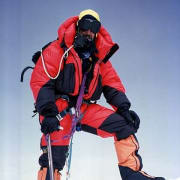The Gear You Need to Climb Mt. Rainier

The Mountaineering Gear You Need
Mountaineering Clothing
• BASE LAYERS: Lightweight moisture-wicking shirts (2 short-sleeve, and 1 long-sleeve) and bottoms (1) - synthetic, no cotton! Also, consider a hoodie - great for base warmth and sun protection. I typically go with 2 pairs of synthetic socks. Remember, you can 'wear' base layers dry while at camp, or in your sleeping bag.
• INSULATION LAYERS: The next layer is comprised of a light softshell jacket, a vest, and a 'puffy' jacket. These layers can be used independently, or together when needed. Add a down, or synthetic, heavily insulated hooded parka - this is your heaviest insulated layer. For pants, go with softshell, or 'climbing' pants.
• OUTER SHELLS: Waterproof (Gore-Tex, or other weather proof material), and windproof jacket and pants. Pants should have full-length zippers for easy on/off access.
• FOR YOUR HEAD: Warm hat or beanie, a sun hat or baseball hat, and a buff for warmth and weather protection.
• FOR YOUR HANDS: Insulated gloves and mittens. Light-weight gloves for climbing in calm/ warm conditions. Mid-weight ski-type gloves for more severe weather, and down or synthetic mittens for the most severe conditions.
• FOR YOUR FEET: Insulated single or double mountaineering boots, depending on weather, and gaiters that fit over your climbing boots.
Climbing Gear
• CRAMPONS: Ensure they're compatible with your boots.
• ICE AX and TREKKING POLES: Make sure to have your ice axe fitted. Do not use the strap on the axe. Trekking poles are optional.
• BACKPACK: Make sure your pack is 60-80L, as you will be packing approx. 40 lbs.
• HARNESS AND ROPE: If you are climbing on a guided expedition the harnesses and ropes will be provided. If not, consult a professional climbing store (e.g. REI) for appropriate rope and length. Your harness should have adjustable leg loops, and should be professionally fitted.
• SNOW ANCHORS and PICKET: For crevasse rescue.
• GLACIER SUNGLASSES AND SKI GOGGLES: 100% UV protection and side shields sunglasses, and ski goggles for extreme conditions.
• HELMUT AND HEADLIGHT: Helmut must meet industry safety standards. Bring extra headlamp batteries.
Shelter
• TENT: A tent that can withstand high winds. If you are on a guided climb the tents are most likely included.
• SLEEPING BAG: Rated for temperatures below freezing.
• SLEEPING PAD: Insulating pad for warmth.
• STOVE AND FUEL: For melting snow and cooking.
Navigation and Communication
• MAP AND COMPASS: Detailed topographic map of the region. This is old-school, but a smart addition. Mapping and compass apps can also be used with your smart phone, but consider battery strength.
• GPS: With extra batteries.
• ALTIMETER: To keep track of your elevation. Many climbing watches have both GPS and an altimeter.
• TWO-WAY RADIOS: For communication within the team.
• EMERGENCY LOCATOR BEACON: For emergencies, including avalanche.
Food and Hydration
• WATER BOTTLES: Total capacity of at least 3 liters.
• FOOD: Food should be high-calorie and high-protein such as energy bars, nuts, snacks etc. I like bringing slices of pizza - a good source of tasty calories! Bring food you like, and not too heavy to carry.
Additional Safety Equipment
• FIRST-AID KIT: Tailored for mountaineering.
• CREVASSE RESCUE EQUIPMENT: Including pulleys, prusiks, and slings.
• SUNSCREEN: SPF 50+ and lip balm with sun protection.
• KNIFE OR MULTI-TOOL: Useful for various tasks.
• TOILET KIT: Including waste disposal bags.
This list provides a foundation for climbing Mt. Rainier, and other glaciated mountain peaks. Always consult with experienced climbers, and adjust gear based on current conditions. Bring every piece of gear that fits in the above categories with you, and select the right gear when you get to the mountain. Safe climbing!
